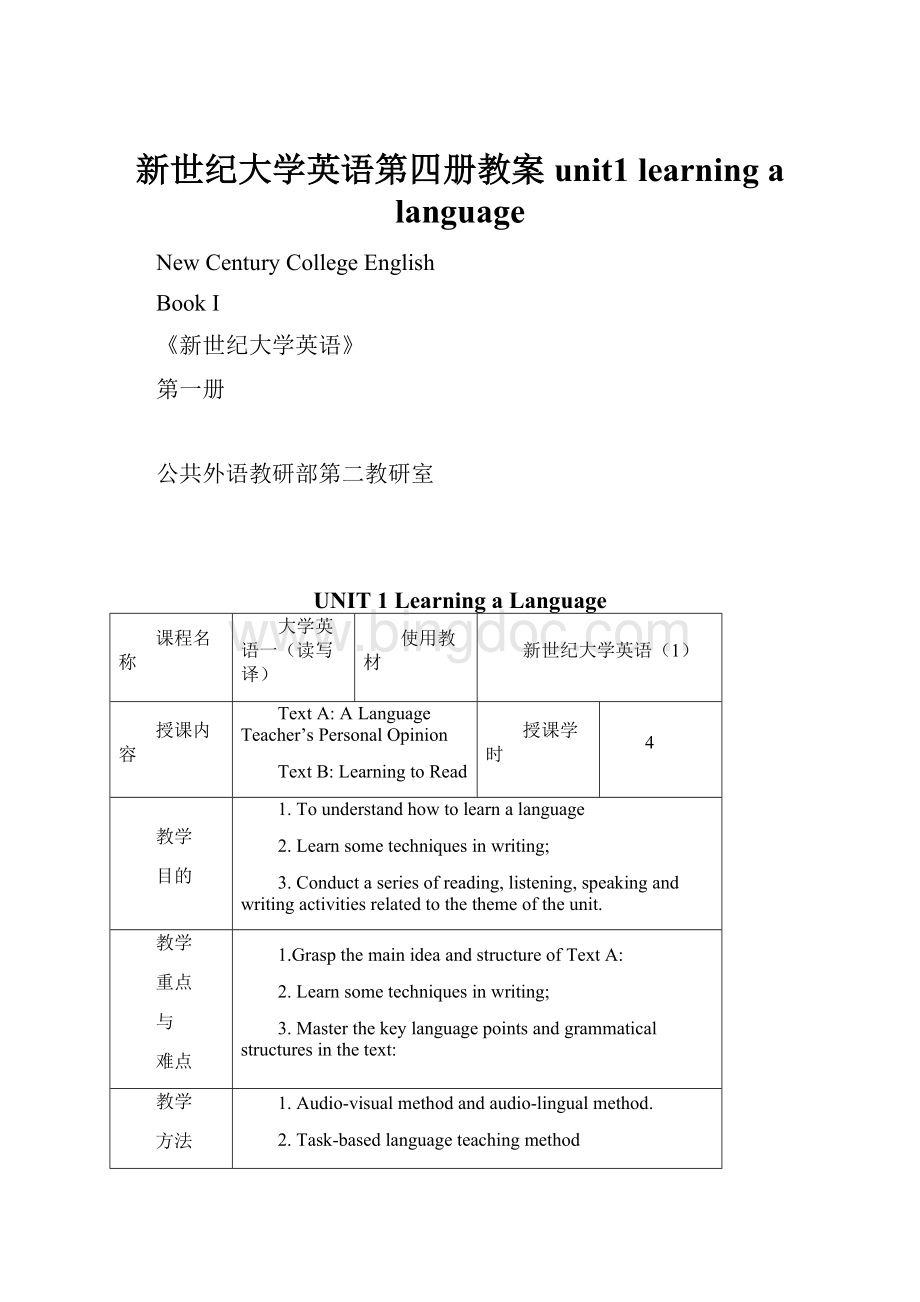新世纪大学英语第四册教案unit1 learning a languageWord格式文档下载.docx
《新世纪大学英语第四册教案unit1 learning a languageWord格式文档下载.docx》由会员分享,可在线阅读,更多相关《新世纪大学英语第四册教案unit1 learning a languageWord格式文档下载.docx(22页珍藏版)》请在冰点文库上搜索。

教学
目的
1.Tounderstandhowtolearnalanguage
2.Learnsometechniquesinwriting;
3.Conductaseriesofreading,listening,speakingandwritingactivitiesrelatedtothethemeoftheunit.
重点
与
难点
1.GraspthemainideaandstructureofTextA:
3.Masterthekeylanguagepointsandgrammaticalstructuresinthetext:
方法
手段
1.Audio-visualmethodandaudio-lingualmethod.
2.Task-basedlanguageteachingmethod
3.Communicativeapproach
4.UsingCAI,PPT
过程
1Pre-readingActivities
Step1.Warm-upquestions
Step2.Thinkandspeak:
Step3.Backgroundinformation
2While-readingActivities
Step1.Globalreading:
understandingTextAasawhole
Step2.Detailedreading:
learningTextAindetail
3Post-readingActivities
Step1.SummarizetheusefulexperessionsinTextA
Step2.DealwithTask3inthetextbook;
Step3.CheckSs’understandingofTextB;
Step4.Someafter-textexercises;
Step5.HomeAssignment.
作业
HomeAssignment
1.Theme-relatedwriting:
WhyIlike/hatetolearnEnglish
2.Previewingofthenextunit.
Unit1LearningaLanguage
1.TeachingObjectives:
Studentswillbeableto
A.Graspthemainideaandstructureofthetext:
B.Learnsometechniquesinwriting;
C.Masterthekeylanguagepointsandgrammaticalstructuresinthetext:
D.Conductaseriesofreading,listening,speakingandwritingactivitiesrelatedtothethemeoftheunit.
2.TimeAllotment:
1stPeriod:
Pre-readingActivities(Warm-upquestions;
Thinkandspeak;
Backgroundinformation)
While-reading(Global-reading:
understandingTextAasawhole)
2ndPeriod:
While-readingActivities(Detailedreading:
learningTextAindetail)
3rdPeriod:
While-readingActivities(Detailedreadingcontinued)
4thPeriod:
Post-readingActivities(SummarizetheusefulexperessionsinTextA;
DealwithTask3inthetextbook;
CheckSs’understandingofTextB;
Someafter-textexercises;
HomeAssignment)
3.TeachingProcedures:
3.1Pre-readingActivities
Step1Warm-upquestions:
Sitingroupsofthreesorfoursanddiscussthefollowingquestions.
1)Doyouthinkitisnecessarytolearnanotherlanguagebesidesyourmothertongue?
2)HowlonghaveyoubeenlearningEnglish?
DoyouthinkEnglishisverydifficulttolearn?
3)Ifpossible,whatotherforeignlanguagesdoyouwanttolearn?
Why?
4)Speakingfromyourownexperience,whateffectivewayswouldyouliketosuggesttohelpotherslearnEnglish?
Method:
Usingtask-basedlanguageteachingmethod,communicativeapproach,andaudio-lingualmethod.
Step2.Thinkandspeak:
1)ImagineyouaretalkingwithabeginnerinEnglish.GivehimsometipsonthebestwaystolearnEnglishfast.
2)ReadtheadviceonhowtolearnEnglish.Checkiftheyaresimilartowhatyouhavewrittendown.
TipsforBeginners
a.Listentotheradio
b.WatchEnglishTVprogrammes
c.TalktoyourselfinEnglish
d.Recordyourownvoice
e.Readsomethingeveryday
f.Recordvocabularyinapersonaldictionary
g.AlwayshaveanEnglish-Englishdictionarynearby
h.Readattheappropriatelevel
i.Keepadiary/journal
j.Listentoautomatedansweringmachinerecordings
UsingCAI,PPT,task-basedlanguageteachingmethod,communicativeapproach,audiolingualmethod.
Step3.Backgroundinformation:
1)LifeofWilliamShakespeare
WilliamShakespeare(1564–1616)isconsideredthegreatestplaywrightwhoeverlived.ShakespearewasborninStratford-upon-Avon.Whiletheactualdateofhisbirthisnotknown,itistraditionallycelebratedonApril23rd.ShakespeareleftStratfordsometimebetween1585and1592,andjoinedacompanyofactorsasaperformerandplaywright.In1594Shakespearebecameanactorandplaywrightforatheatertroupe(剧团).UntiltheendofhisLondoncareerShakespeareremainedwiththecompany;
asanactorheplayedoldmen’sroles,suchastheghostinHamletandOldAdaminAsYouLikeIt.In1599hebecameapartnerintheownershipoftheGlobeTheatre,andin1608hewaspartowneroftheBlackfriarsTheatre.ShakespeareretiredandreturnedtoStratford.Heundoubtedlyenjoyedacomfortablelivingthroughouthiscareerandinretirement,althoughhewasneverawealthyman.
2)CharlesDickens:
(refertotextbookPage8)
3)Behavioristspsychology:
(refertotextbookPage8)
Usingtask-basedlanguageteachingmethod,readingapproach.
3.2While-readingActivities
Step1.Globalreading:
DosomeexercisestocheckSs’previewingofthetextandunderstandingofitasawhole.
1)ThefollowingaresomeviewpointsaboutEnglishlearningquotedfromTextA.Doyouagreewiththem?
Whatarethepossibleattitudesoftheauthortowardsthem?
a.OnemaylearntospeakEnglishfluentlyinthreemonthswithpropermethods.
b.Theonlywaytolearnalanguageistospendagreatdealoftimeinthecountrywhereitisspoken.
c.OnecanteachhimselfEnglishathomewithtextbooksanddictionaries.
d.NoonecaneverlearntospeakEnglishoranyotherlanguageunlessheisinterestedinit.
2)TextAhassixparagraphs(1-6).Choosethemostsuitableheadingforeachparagraphfromthelistofheadingsbelow.
A)Agoodmethodthatsuitsallstudentsdoesnotexist
B)Thebehavioristapproach
C)TwofalseattitudestowardEnglishlearning
D)Theroleoffellowstudents
E)Advertisementsoftengivethefalseimpression
F)Theroleofinterest
1-E2-A3-C4-B5-F6-D
3)Questionsaboutthetext:
a.AccordingtoWillPidcroft,thewriterofthistext,canEnglishbemasteredwithinaveryshortperiodoftime?
b.Whatisthebeliefheldbybehavioristsintermsoflanguagelearning?
c.WhatdoesPidcroftsayaboutone’sinterestinlanguagelearning?
d.WhatdistinguisheshumanbeingsfromparrotsandchimpanzeesaccordingtoPidcroft?
Textstructure:
Part1:
Para.1ItisimpossibletolearnEnglisheasilyastheadvertisementsclaims.
Part2:
Paras.2-4Thereisnoall-purposewaythatsuitsallstudentsinlearningEnglish.
Part3:
Paras.5-6Interestisthekeytolearningalanguage.Anditisalsoimportanttohaveotherpeopletotalktoandlistentowhenwecommunicate.
Purpose:
Improvingstudents’readingandwritingskillandunderstandingthegeneralideaofeachparagraph.
Usingtask-basedlanguageteachingmethod,readingapproach,communicativeapproachandtotalphysicalresponsemethod.
Step2.Detailedreading:
1)Studentsareaskedtoreadthepassagecarefullyagainanddiscussthedifficultsentencesandsentencestructures.
2)DealwithTask1andTask2inthetextbook;
3)HelpSsfindoutthegoodusageinthetextandunderlinedthem(refertotheteacher’sbook);
4)SummarizetheuseoftheSubjunctiveMoodinthetext(askSsdotheGrammarReviewinthetextbookafterclass).
Furtherunderstandthetext(Trainfurtherreadingability)tofindoutsomedifficultsentencesanddetailsofthetext.
Readingthetexttogether;
Usingtask-basedlanguageteachingmethod,readingapproach,communicativeapproach,grammar-translationapproachandtotalphysicalresponsemethod.
Difficultsentences:
1.ThereisoftenareferencetoWilliamShakespeareorCharlesDickenstoencouragehimevenmore.
Whoare“WilliamShakespeare”and“CharlesDickens”?
(=Shakespeareistheworld’smostpopularplaywrightwhileDickensisthegreatestEnglishnovelistofthe19thcentury.)
Whyaretheymentionedintheadvertisements?
(=Thepeoplewhoruntheadvertisementsjustwanttousequotationstosupporttheirpoints.)
2.IfitwereaseasytolearnEnglishastheysay,Iwouldhavetolookforanotherjob,becauseveryfewqualifiedteacherswouldbeneeded.
Whatistheauthor’sprofession?
(=HemustbeanEnglishteacherwhosejobistotrainqualifiedEnglishteachers.)
3.…,anditisnousepretendingthatanyonehasdiscoveredaperfectwayofteachingEnglishineverypossiblesituation.
Whatarethemeaningandtheusageofthephrase“itisnouse…”?
(=Thephrasemeans“ithasnoeffect…”.)
2)WheneverweusethisphraseweshouldalwaysusetheV-ingformafterit.
Moreexamples:
*It’snousecomplaining.
*It’snousecryingoverspiltmilk,—he’sspentallthemoney,andthere’snothingyoucandoaboutit.)
TranslatethispartintoChinese.
(=而且也无需装模作样地声称有什么人已经找到了一个万能的适合所有学习环境的教学方法。
)
4.Nodoubtthisistruetoacertainextent,butitisnotveryhelpfultostudents.
Whatcanwelearnfromtheexpression“Thisistruetoacertainextent,but…”?
(=Wecanseetheauthordoesn’ttotallyagreewiththepreviousstatement.
Then,what,intheauthor’sopinion,ishelpfultostudents?
(=StudentsshouldhavesomegoodmethodsinlearningEnglish.)
5.Somestudentsgototheoppositeextremeandthinktheycanteachthemselvesathomewithdictionaries.
Whatcanweinferfromthephrase“gototheoppositeextreme”?
(=Fromthisphrase,wecanseethattheauthordoesn’tthinklearningEnglishbyusingdictionariesonlyisagoodmethod,either.)
6.ButitiswrongtoassumethateachwordinEnglishhasapreciseequivalentinanotherlanguageandviceversa.
TranslatethesentenceintoChinese.
(=如果你认为英语中的每一个词在另一语言中都有完全对等的词(或反之亦然),那就错了。
7.Ifwewereparrotsorchimpanzees,thesemethodsmightbesuccessful.
Whatcanweinferfromthesentence?
(=Theauthorusessubjunctivemoodheretoshowhedisagreeswithbehaviorists.)
8.Humanbeings,unlikeparrotsandchimpanzees,…canrelatethemtotheirownlives.